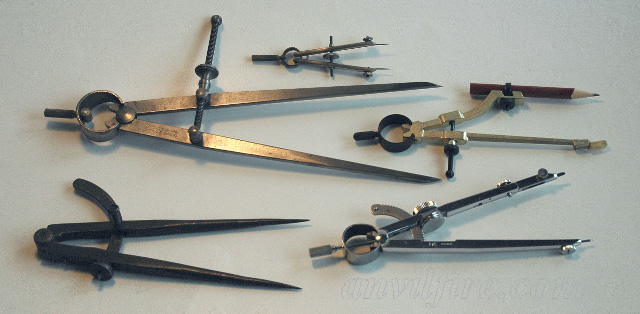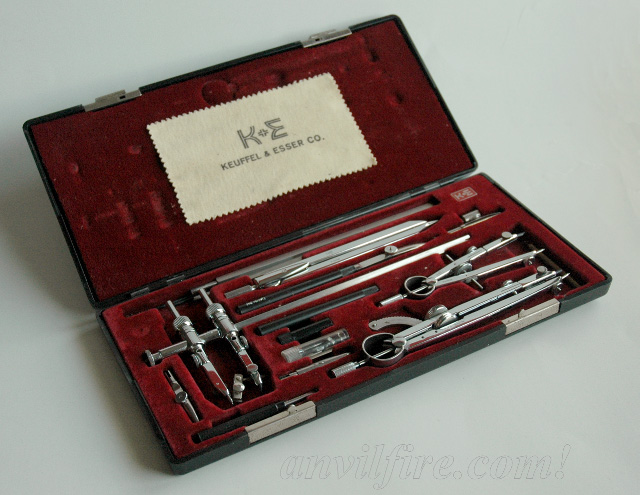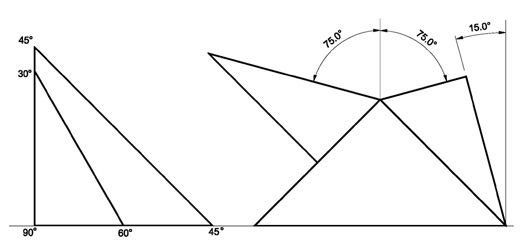BASIC TOOLS
The Compass and Divider
Tools that built our world
 Starrett Spring Dividers, Wing Dividers, Students or Carpenters Brass Compass and K&E Draftman's Speed Compass.
Starrett Spring Dividers, Wing Dividers, Students or Carpenters Brass Compass and K&E Draftman's Speed Compass.
These simple tools probably date to the time of mankind's earliest civilizations.
It is the most basic of drawing tools surpassed only by the straight edge.
The earliest dividers had a friction or "firm" joint. Later they had a curved bar added to clamp them in position.
Modern compass and dividers such as the Starretts above have a fine adjusting screw.
Every elementry school student learns that a compass is used to draw circles.
But it is a much more powerful tool,
so much so that the Ancient Greeks believed that every true mathematical proof could be demonstrated with a compass and a straight edge.
This has been proved wrong in some cases such as where the solution is an irrational number, but mathematicians still take up the challange.
 K&E Compass Set.
K&E Compass Set.
Includes friction joint dividers, 32" beam compass, ink pen holder and points, small 4" screw compass
and patent speed compass, all brass and chrome plated. This is probably the finest compass set ever made.
Cost $235 in 1983. Used almost every day for 20 years.
As a drawing tool the compass can obviously draw circles and concentric circles.
But it can be used to layout other geometric shapes as well.
The equal lateral triangle, square, hexagon, octagon and more without iteration.
Other geometric shapes with odd number of sides such as the pentagon are made using dividers and iteration (guess and adjust).
 The two shapes above are important for many reasons.
Squares are used for calculating areas, the starting point for many geometric constructions and building almost everything.
The six sided hexagon is a common important bolt circle on many devices and is another starting point in geometric layouts.
These two layouts also become important basic engineering drawing tools, the 45° triangle and the 30/60 triangle.
Together these two triangles and a straight edge or T-square give the ability to make engineering drawings with 15° increment lines without the use of a protractor.
The two shapes above are important for many reasons.
Squares are used for calculating areas, the starting point for many geometric constructions and building almost everything.
The six sided hexagon is a common important bolt circle on many devices and is another starting point in geometric layouts.
These two layouts also become important basic engineering drawing tools, the 45° triangle and the 30/60 triangle.
Together these two triangles and a straight edge or T-square give the ability to make engineering drawings with 15° increment lines without the use of a protractor.
 These basic drafting tools can be made from wood, metal or plastic - the only tool necessary for their accurate design, the compass.
A generation ago these were still common drawing tools used by artists and engineers but soon there will be few who remember them or know how to use them, much like the abacus (which is still used by the Japanese and is faster than a pocket calculator).
CAD has taken over technical drawing and CNC machines have replaced manual layout even though the manual processes are faster and more efficient for simple jobs.
These basic drafting tools can be made from wood, metal or plastic - the only tool necessary for their accurate design, the compass.
A generation ago these were still common drawing tools used by artists and engineers but soon there will be few who remember them or know how to use them, much like the abacus (which is still used by the Japanese and is faster than a pocket calculator).
CAD has taken over technical drawing and CNC machines have replaced manual layout even though the manual processes are faster and more efficient for simple jobs.

Besides drawing relative angles the straight edge with the compass and squares can be used to make sophisticated mathematical curves and graphs.
Many data sets follow these mathematical curves so the ability to lay them out was an important skill for statisticians and scientists.

Methods of geometrical layout are found in drafting books, math books and engineering references such as
MACHINERY'S HANDBOOK.
ABOVE: Parts of pages 255 and 256 of the 3rd edition above.
In the shop the square and dividers are used to layout parts to be machined and accurate bolt circles for flanges and
CAD Computer Aided Design or Computer Aided Drafting has practicaly eliminated the use of standard drafting tools such as those above.
Even in this article we have used CAD to create our diagrams.
However, in the shop CAD will not make your layout on your material without transfer from paper and is especially difficult on large sheets.
The Starrett Book for Machinists Apprentices
|


BASIC TOOLS
The Compass and Divider
Tools that built our world
These simple tools probably date to the time of mankind's earliest civilizations. It is the most basic of drawing tools surpassed only by the straight edge. The earliest dividers had a friction or "firm" joint. Later they had a curved bar added to clamp them in position. Modern compass and dividers such as the Starretts above have a fine adjusting screw.
Every elementry school student learns that a compass is used to draw circles. But it is a much more powerful tool, so much so that the Ancient Greeks believed that every true mathematical proof could be demonstrated with a compass and a straight edge. This has been proved wrong in some cases such as where the solution is an irrational number, but mathematicians still take up the challange.
Includes friction joint dividers, 32" beam compass, ink pen holder and points, small 4" screw compass and patent speed compass, all brass and chrome plated. This is probably the finest compass set ever made. Cost $235 in 1983. Used almost every day for 20 years.
As a drawing tool the compass can obviously draw circles and concentric circles. But it can be used to layout other geometric shapes as well. The equal lateral triangle, square, hexagon, octagon and more without iteration. Other geometric shapes with odd number of sides such as the pentagon are made using dividers and iteration (guess and adjust).
Besides drawing relative angles the straight edge with the compass and squares can be used to make sophisticated mathematical curves and graphs. Many data sets follow these mathematical curves so the ability to lay them out was an important skill for statisticians and scientists.
Methods of geometrical layout are found in drafting books, math books and engineering references such as MACHINERY'S HANDBOOK. ABOVE: Parts of pages 255 and 256 of the 3rd edition above.
In the shop the square and dividers are used to layout parts to be machined and accurate bolt circles for flanges and
CAD
Computer Aided Design or Computer Aided Drafting has practicaly eliminated the use of standard drafting tools such as those above. Even in this article we have used CAD to create our diagrams. However, in the shop CAD will not make your layout on your material without transfer from paper and is especially difficult on large sheets.The Starrett Book for Machinists Apprentices